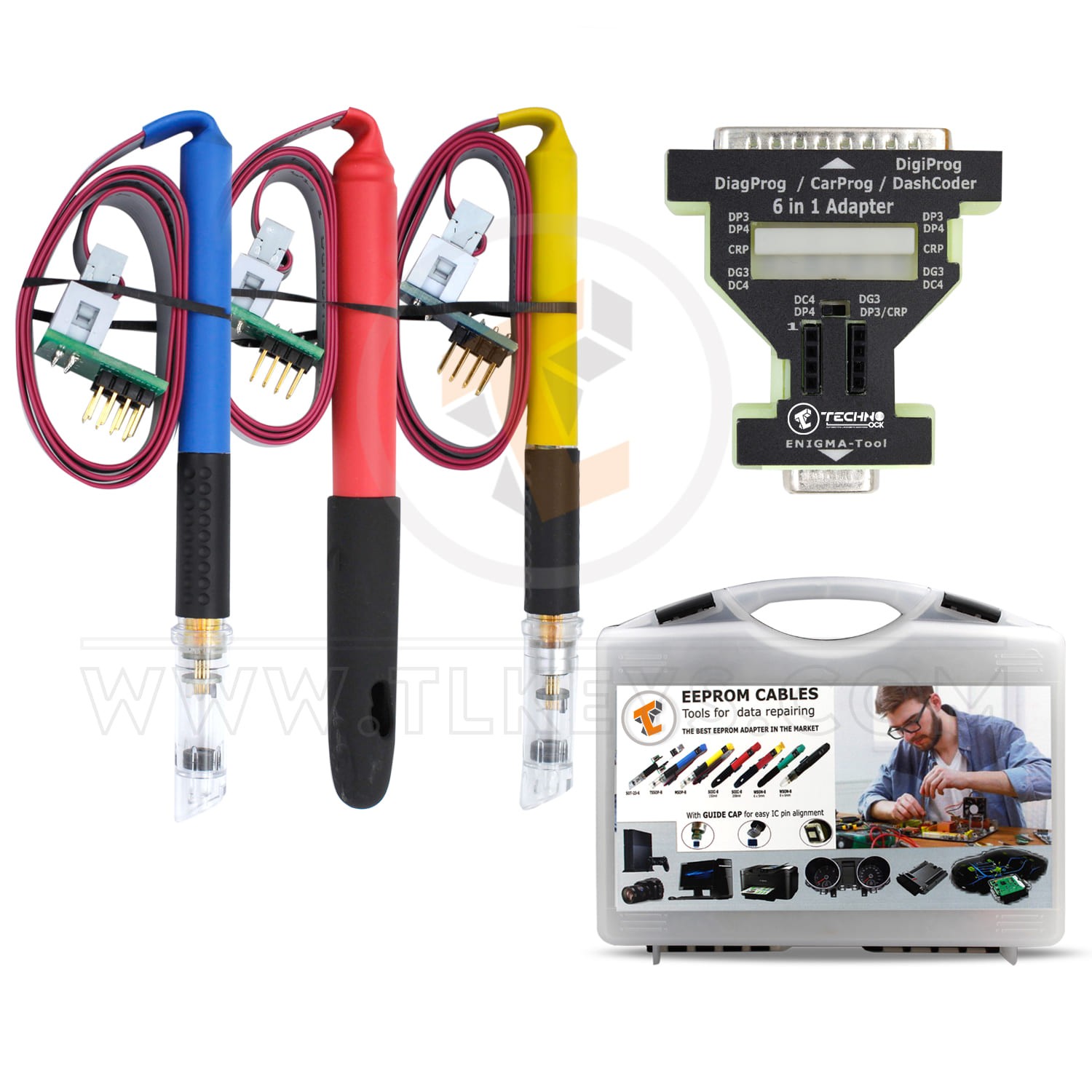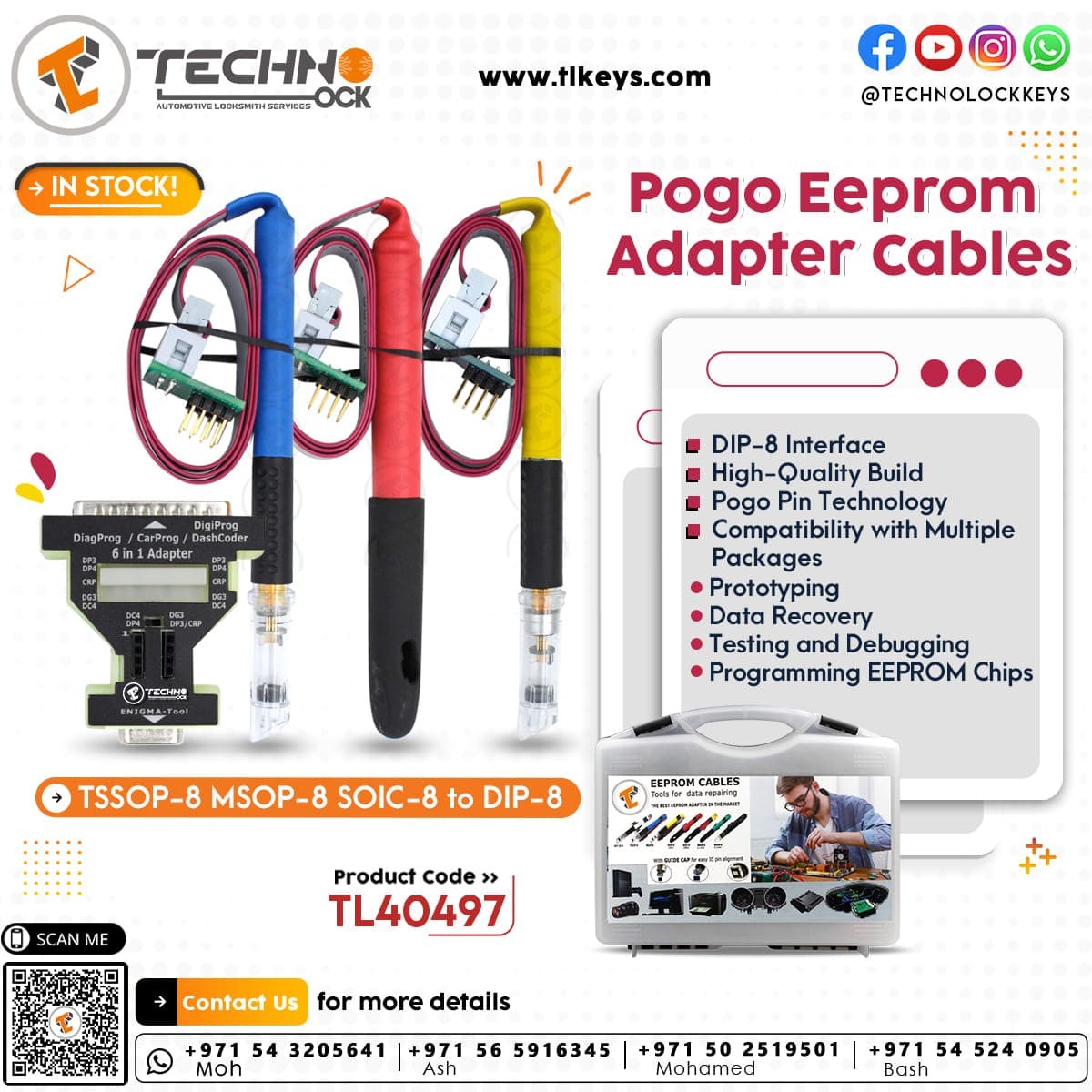
| Weight | 0.3 kg |
|---|
| Weight | 0.3 kg |
|---|
Pogo Adapter for EEPROM Programming
The Pogo Adapter is an innovative tool used for programming and connecting EEPROM memory chips. This adapter consists of a set of small connectors that allow various types of chips to interface with standard programming tools.
Included Adapters
The Pogo Adapter includes six different adapters:
- TSSOP-8
- MSOP-8
- SOIC-8
- DIP-8
- DG
- DC4
This variety allows you to connect a wide range of EEPROM chips to any programming tool that supports DIP-8.

Common Uses
The Pogo Adapter is widely used by electronics professionals and hobbyists for programming EEPROM chips in various electronic projects. It is a versatile tool that eliminates the need for multiple programming devices.
Key Features
- Compatible with a wide variety of EEPROM chips
- Easy to use
- Compact and lightweight
- Durable and reliable
- Affordable price
Using the Pogo Adapter
In the image, we can see the Pogo Adapter with its six connectors. To use the Pogo Adapter for programming an EEPROM chip, simply place the chip into one of the connectors and then connect the adapter to your programming tool.
Applications
- Programming EEPROM chips in electronic projects
- Repairing electronic devices
- Developing firmware
- Research and development
Comparison with Other EEPROM Adapters
When compared to other EEPROM adapters on the market, the Pogo Adapter stands out due to its versatility, ease of use, and affordable price. Many adapters are designed to support only specific types of chips, requiring users to purchase multiple adapters for different projects. In contrast, the Pogo Adapter's comprehensive set of connectors allows it to interface with a wide range of EEPROM chips, making it a one-stop solution for most programming needs.
Furthermore, the Pogo Adapter is designed with user convenience in mind. Its compact and lightweight design ensures that it can be easily transported and used in various settings, whether in a professional lab or a hobbyist's workspace. The straightforward design also means that users can quickly and easily switch between different connectors, reducing downtime and increasing productivity.
Additionally, the Pogo Adapter's durability and reliability ensure that it can withstand frequent use, making it a long-term investment. Despite its high-quality construction and versatile functionality, the Pogo Adapter is priced competitively, offering excellent value for money compared to other adapters that may be more limited in their application.
Specification Comparison Table
| Feature | Pogo Adapter | Competitor A | Competitor B |
|---|---|---|---|
| Number of Adapters Included | 6 | 3 | 4 |
| Types of Chips Supported | TSSOP-8, MSOP-8, SOIC-8, DIP-8, DG, DC4 | SOIC-8, DIP-8, TSOP-8 | SOIC-8, DIP-8, MSOP-8, TSSOP-8 |
| Compatible Programming Tools | Any tool supporting DIP-8 | Specific to brand | Generic tools |
| Ease of Use | High | Medium | High |
| Portability | Compact and lightweight | Bulky | Compact |
| Durability | High | Medium | Medium |
| Price | Affordable | Expensive | Moderate |
Step-by-Step Guide to Using the Pogo Adapter
Follow these steps to use the Pogo Adapter for programming an EEPROM chip:
- Identify the EEPROM chip type: Determine the type of EEPROM chip you need to program (e.g., TSSOP-8, MSOP-8, SOIC-8, etc.).
- Select the appropriate adapter: Choose the corresponding adapter from the Pogo Adapter set that matches your EEPROM chip type.
- Insert the EEPROM chip: Carefully place the EEPROM chip into the selected adapter, ensuring correct orientation and alignment with the adapter pins.
- Connect to the programming tool: Attach the Pogo Adapter to your EEPROM programming tool. Ensure a secure connection between the adapter and the programming tool.
- Power on the programming tool: Turn on your programming tool and ensure it recognizes the connected EEPROM chip.
- Load the programming software: Open the EEPROM programming software on your computer and select the appropriate settings for the EEPROM chip you are programming.
- Program the EEPROM chip: Follow the software instructions to read, write, or erase data on the EEPROM chip. Verify the programming process to ensure the data has been correctly written.
- Disconnect the adapter: Once programming is complete, safely disconnect the Pogo Adapter from the programming tool and remove the EEPROM chip from the adapter.
By following these steps, you can easily and effectively program EEPROM chips using the Pogo Adapter.
Common EEPROM Issues and Solutions Using the Pogo Adapter
1. Corrupted EEPROM Chip
Issue: EEPROM chips can become corrupted due to electrical issues, software errors, or physical damage. This can lead to devices malfunctioning or failing to start.
Solution: Using the Pogo Adapter, you can reprogram the corrupted EEPROM chip. Follow the steps outlined in the "Using the Pogo Adapter" section to rewrite the correct firmware or data onto the chip, restoring its functionality.
2. Data Recovery from a Malfunctioning EEPROM
Issue: Sometimes EEPROM chips may stop working properly, causing loss of critical data stored in them.
Solution: The Pogo Adapter can be used to read the data from the malfunctioning EEPROM chip. Connect the chip to the Pogo Adapter and use your programming tool and software to extract the data, which can then be transferred to a new chip if necessary.
3. EEPROM Chip Replacement
Issue: When an EEPROM chip is damaged beyond repair, it needs to be replaced with a new one, which must be programmed with the appropriate data or firmware.
Solution: With the Pogo Adapter, you can easily program a new EEPROM chip by following the programming steps. Once programmed, the new chip can be installed in place of the damaged one.
4. Firmware Updates
Issue: Devices often require firmware updates to improve performance, add new features, or fix bugs. Updating the firmware on EEPROM chips can be challenging without the right tools.
Solution: The Pogo Adapter simplifies the process of updating firmware on EEPROM chips. Simply connect the chip to the adapter, use the programming tool to load the new firmware, and program the chip as described in the usage guide.
By addressing these common EEPROM issues, the Pogo Adapter proves to be an essential tool for both professional electronics technicians and hobbyists, ensuring reliable programming and maintenance of EEPROM chips.
Types of EEPROM Chips:
- TSSOP-8: Thin Shrink Small Outline Package with 8 pins.
- MSOP-8: Mini Small Outline Package with 8 pins.
- SOIC-8: Small Outline Integrated Circuit with 8 pins.
- DIP-8: Dual Inline Package with 8 pins.
- DG: This could refer to a specific type of package or chip designation.
- DC4: This could also refer to a specific type of package or chip designation.
Choosing the Right EEPROM Chip for Your Project:
- Identify Your Project's Requirements: Determine the specific needs of your project, such as memory capacity, operating voltage, physical size constraints, and interface compatibility.
- Review Datasheets: Consult the datasheets of various EEPROM chips to compare their specifications and features. Pay attention to parameters like memory size, operating voltage range, speed, and endurance.
- Consider Package Type: Evaluate the package type that best suits your project's requirements and design constraints. Consider factors such as board space, ease of soldering, and compatibility with your PCB layout.
- Check Interface Compatibility: Ensure that the EEPROM chip you choose is compatible with the communication interface (e.g., SPI, I2C) supported by your microcontroller or programming tool.
- Assess Environmental Conditions: Consider the environmental conditions in which your project will operate, such as temperature range and humidity. Choose an EEPROM chip that can withstand these conditions reliably.
- Plan for Future Expansion: Anticipate any future scalability or expansion needs of your project. Choose an EEPROM chip with sufficient memory capacity and flexibility to accommodate future updates or additions to your firmware or data storage requirements.
By carefully evaluating these factors and selecting the appropriate EEPROM chip for your project, you can ensure reliable performance and compatibility with your design objectives.
Conclusion
The Pogo Adapter is a valuable tool for programming and connecting EEPROM memory chips. It is compatible with a variety of chips, easy to use, compact, and lightweight. If you need a tool for programming EEPROM chips, the Pogo Adapter is an excellent choice. Its versatility, user-friendly design, and affordability make it a standout option in the market.
